In the early days when I was at University bikes were an essential form of transport. They were also tremendous fun as you can probably tell from the previous post where my objective seemed to be to get the biggest and fastest bike as soon as possible.
https://v2xs.com/bikes-the-early-years/
On leaving University in Durham and starting work at Ricardo on the South Coast I had to switch to using a car for my everyday transport and, like most poeple, that necessity continues to this day. But most cars are not much fun and there was always a desire to have a bike as well…
Rickman Kawasaki Z1000
The last bike I owned was the Honda CBX, which was fast and sophisticated but rather heavy and cumbersome. I had always been happy with the power and reliability of Japanese bikes but the handling and braking often left something to be desired. Having been at work for a while I started to search for an interesting “toy” bike that would be fast and have good handling. And what could be better than buying a road-legal race bike ?
I managed to find a Rickman Kawasaki and bought it from a guy only a few miles from where I was living in Worthing – he had upgraded to a Bimota Suzuki. The Kawasaki was an ex. TT Racer and actually competed in the 1979 Formula 1 TT on the Isle of Man. The previous owner had bought it as a race bike and fitted lights and number plate and managed to get it road registered. It had a highly tuned engine (the original Kawasaki engine was already pretty close to the CBX on power) and a Rickman frame with proper brakes. The Rickman Brothers are specialist frame manufacturers in the UK and have a trade mark of nickel plating their frames. They are much lighter and stiffer than the originals – ideal for racing.
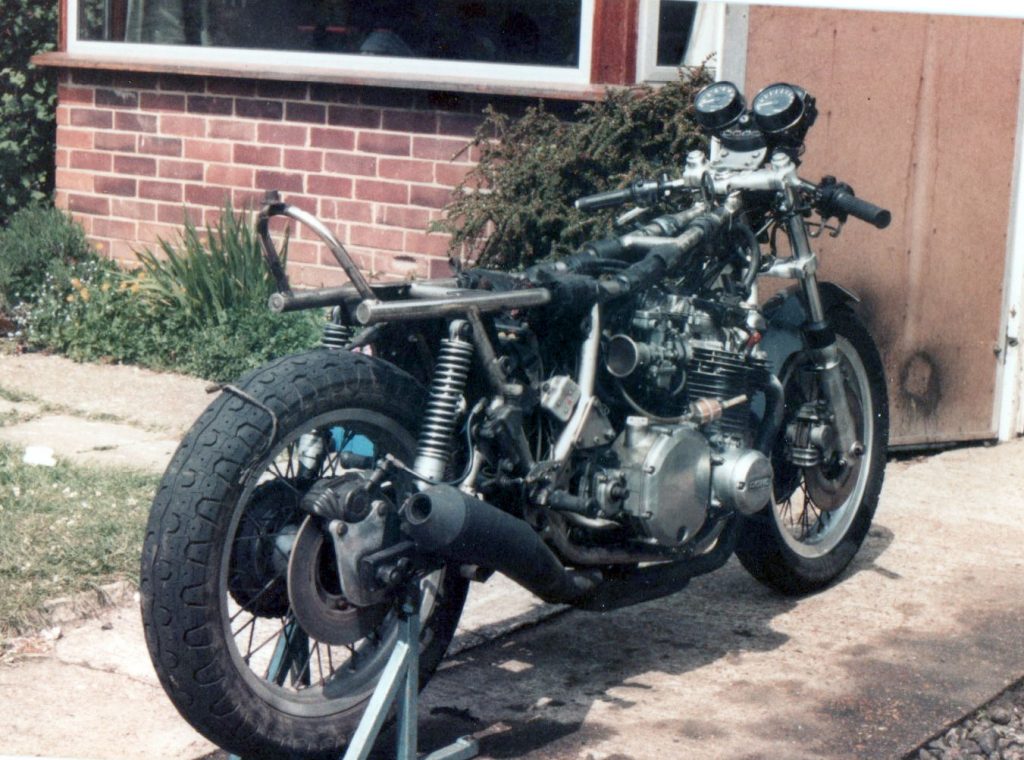
Impressions of the bike ? Exactly like a race bike on the road, with all the pros and cons that go with that. On a fast open stretch of road it was extremely fast, controllable and exhilirating. Anywhere else it was a bit of a pain. Commuting to work through the traffic was tiresome as the riding position puts a lot of weight on the arms unless going fast enough for the wind pressure to offer some relief. the engine was quite peaky – lots of power at the top end but not so much low down torque. As a toy for a weekend blast it was hard to beat, but as daily transport it was not so good.
It’s interesting that in looking for a new bike I always seemed to be in pursuit of something better, bigger, faster and now, having got the fastest bike available I’m a bit disappointed with it. Did I learn a lesson from this ? Of course not as this is about big boys toys and common sense and reason go out of the window. So where do you go from here ?
Well I put on my rose tinted spectacles and remembered the “good old days” of my first bike the Yamaha RD250 and what fun that was. It probably had about 30 bhp and might manage 100 mph on a good day, compared to the Kawasaki with over 100 bhp and 150 mph potential. There’s no doubt which one would win a race, but which was more fun ?
Yamaha RD400
This was a 1978 bike and the bigger brother of the RD250 I used to have.

This was a bike much more suited to local commuting and having fun at sensible speeds and I embarked on a series of modifications..
I fitted lower handlebars and rearset footrests, added a steering damper and I can see from the photo that I had to make some little alloy brackets to support the headlight with the new bars fitted. However, the biggest modification was to the exhaust system which was a project in itself…
On joining Ricardo I met up with my mate Doug CARTWRIGHT who was in to kart racing. We used to go all over the country to compete in the 125 championship – my role was to help with the spannering and share some of the long drives in Doug’s old Opel Rekord diesel estate. The 125 Rotax was a very high performance 2 stroke engine and as we worked for an engine R&D company we spent some time developing the engine on a dynamometer. I wondered about doing some tuning of my own on the RD400…
Two strokes respond very well to exhaust tuning as the standard exhaust is quite restrictive so I started by doing some dynamometer runs on the standard bike to get a baseline and then designed some expansion chambers which I believed would give me more power. I am not a designer, but having drawn a 2D representation of the pipes I gave them to my friend John KIDD (Pongo) who was working with the CAD system. He converted the 2D layouts into 3D CAD, then “cut” the pipes into sections and “unrolled” each section to give a flat paper drawing of each of the pieces I would need to make the pipes. It was then just a matter of cuttung out these shapes in steel sheet, rolling the cone shapes and welding it all together – which did take me a little while. These were all assembled onto the bike (as shown in the photos) and retested on the dyno..
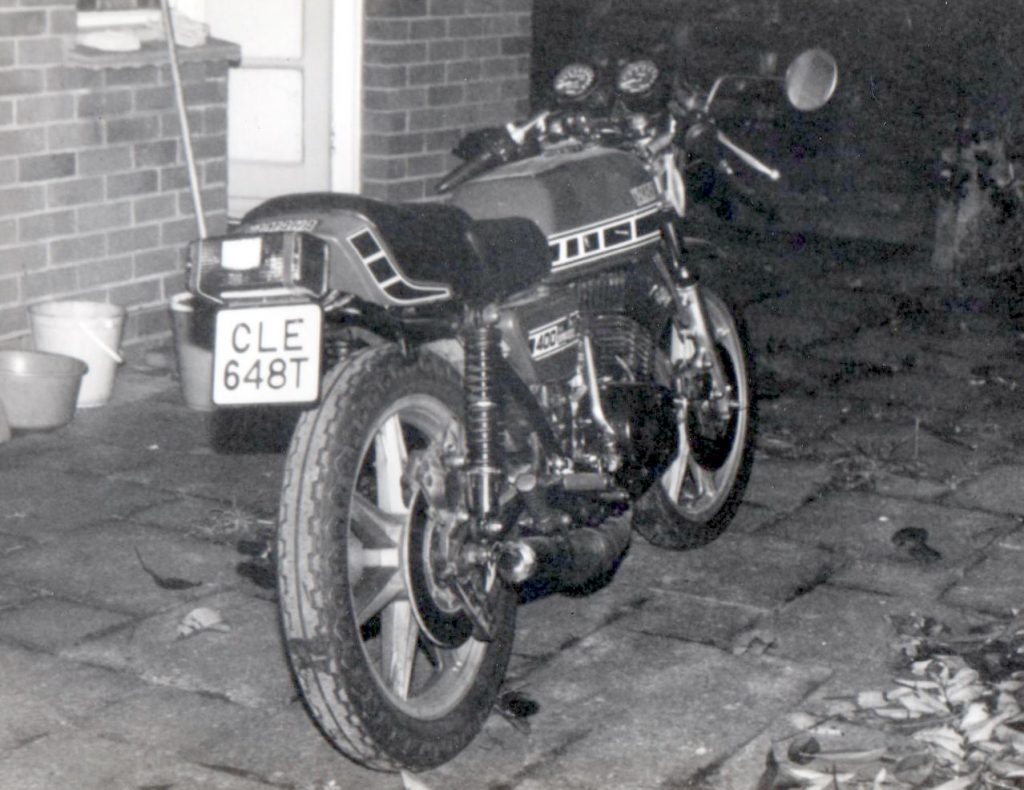
I was pleased to find the bike “revved out” further and produced more power – pretty much what I had designed the pipes to do. However, there was a loss of low speed torque and driveability… So it turned out that the original pipes were a pretty good compromise and for nipping in and out of commuter traffic the low down response is actually more useful than more top end power. It seems we have had this lesson before…
Taking the first step on the ladder of being grown up and more sensible was marked by moving from rental accommodation and buying a flat with my girlfriend. Having no garage and probably no money left over were also contributing factors to spending a few years without a bike. And then, within a few weeks of us splitting up, I was on the hunt for a new bike… Having clearly learnt no lessons from all my bike ownership experience I set out to find something stupidly fast and fun…
Suzuki GSXR750
We are now in the late 80s and motorcycles have come on a lot in the last 10 years. A new category of race-replica bikes have emerged – maybe the Phil Read Replica was the first ? But these bikes are not just cosmetic make-overs, the engine, suspension, brakes and tyres have all moved on dramatically from the late 70s.
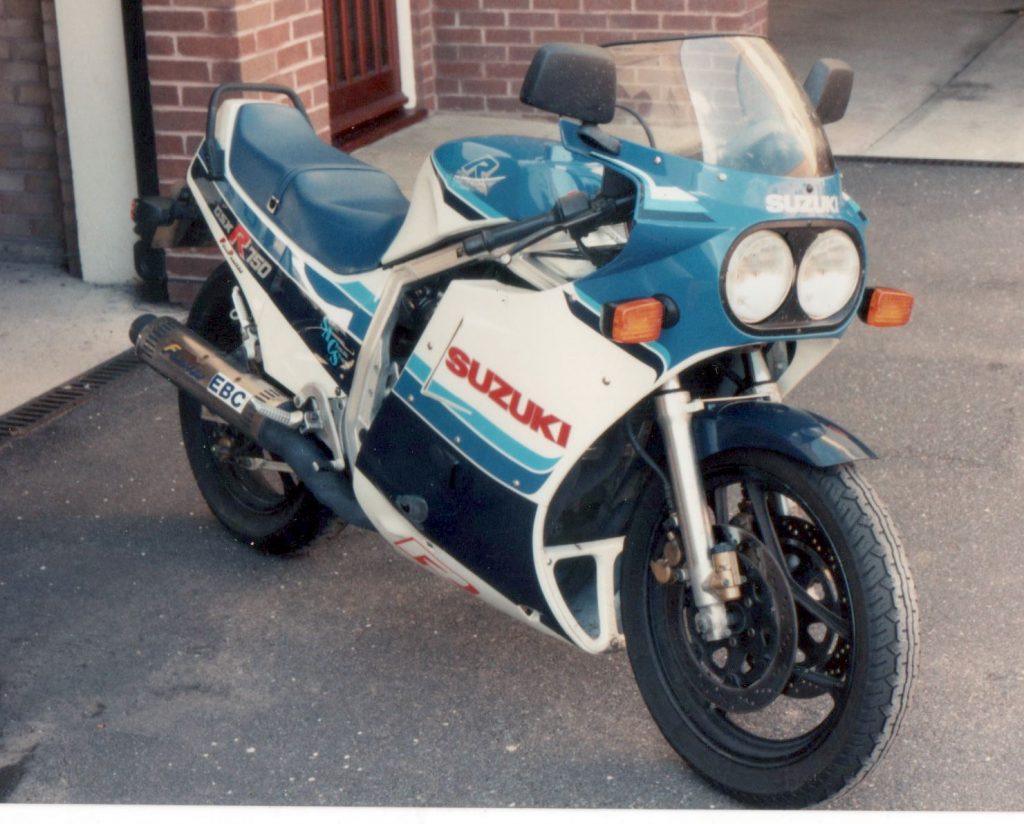
As a comparison the Honda CBX which was the fastest thing out there in 1981, was a 1000cc six cylinder producing 100 bhp and weighing 274 kg. The 1986 GSXR750 produced 106 bhp and weighed 205 kg.
The GSXR was extremely fast, capable and exciting. It was more useable than the Rickman Kawasaki, being a road bike rather than a pure racer – but still suffered from the same character traits. Looking back it is obvious now but at the time I seemed to value the sheer excitement more than the overall riding experience. The Suzuki was perfect for the race track or fast roads but in West Sussex, amongst the traffic there was very little opportunity to use even half of its potential.
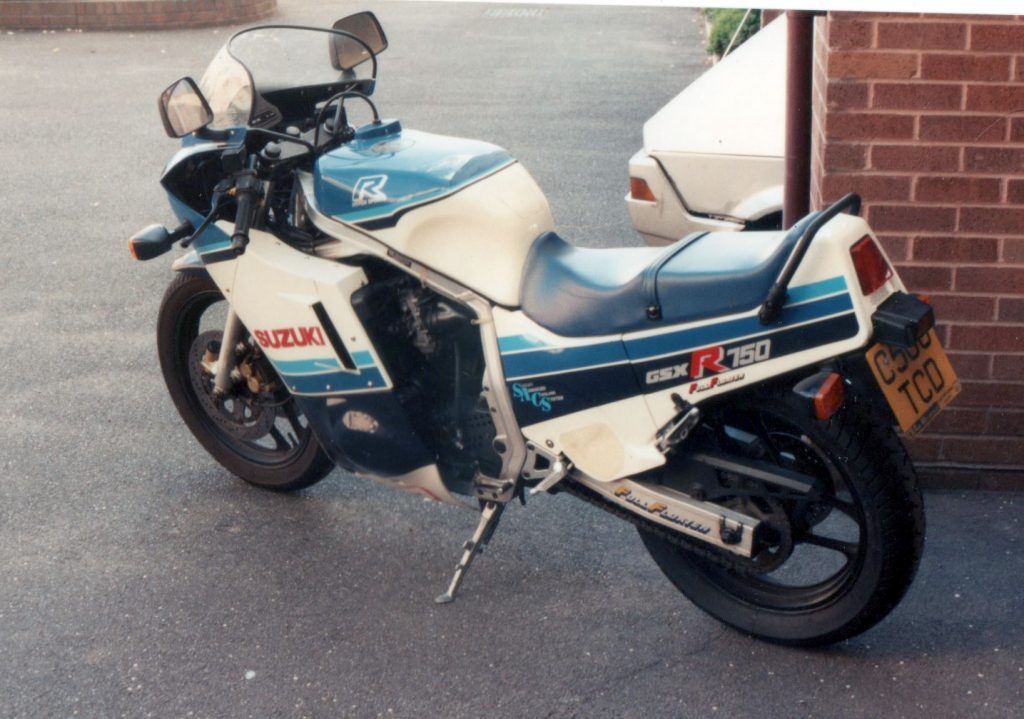
Modifications ? None – it didn’t need any. It only came with a side stand so I did get one of the apprentices to make me up a paddock stand – but that’s about it. This would have been a perfect bike for “track days” but such things didn’t really exist back then. Great fun in small doses…
We now enter another bike desert as we move further up the ladder of growing up – getting married, buying a house, starting a family…
But the desire to have a toy is still there, it’s just a matter of time… Fast forward to 2000 – have I learnt any lessons yet about the type of bike I should look for ? Bikes have continued to develop and are getting faster and more powerful – but also generally lighter and with top quality suspension, brakes and tyres. I have started to realise (it took a long time), maybe influenced by my increased responsibilities that going for a race-replica superbike is not the right choice. I made that mistake a few times and certainly enjoyed the buzz when you could unleash some of the potential. I have had many opportunities since then to go down the “faster is better” route but have managed to resist temptation (so far at least).
So the search began for a bike that would be fun and enjoyable at low speed (<80 mph), rather than one that can reach that speed in second gear. And this lead to a Supermoto…
KTM 640 LC4
The supermoto concept is fairly simple – you take a dirt bike with its high up riding position and long travel suspension, bolt on some smaller road wheels with sticky rubber and a massive brake disc on the front – and away you go ! The supermoto idea really took off in France where they have a race series specifically for this class of bike that involves riding on a race circuit but with some off road sections thrown in. KTM are leaders in the off road world and were one of the first to embrace the concept and offer an off-the-shelf supermoto.
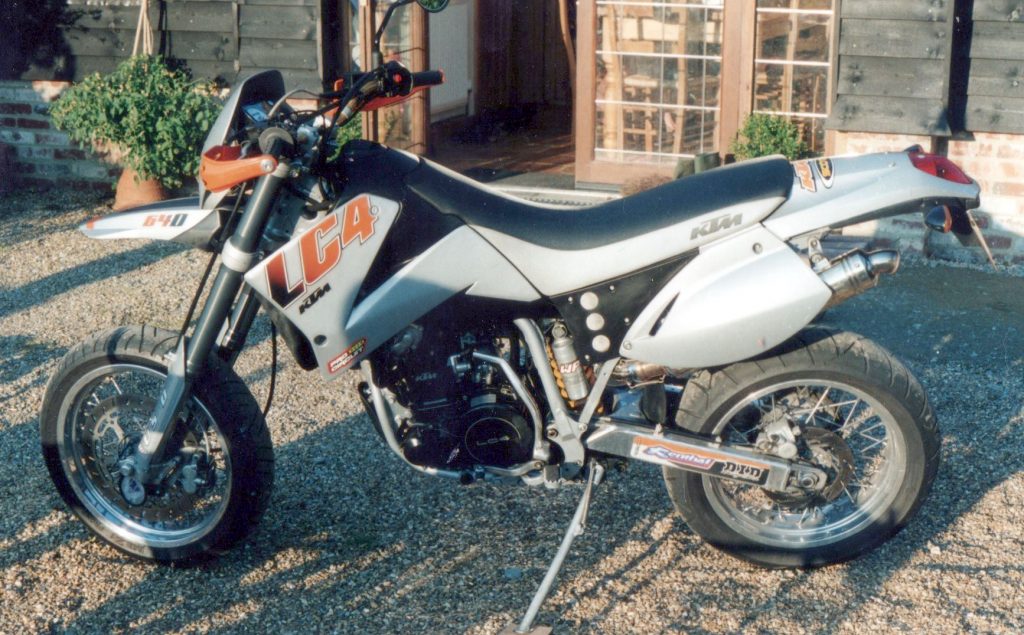
What appealed to me was the idea that you could go fast and have fun without getting up to silly speeds. These bikes are light – 150 kg but still produce 55 bhp. Compare this to the Honda 550 I had in Durham – 190 kg and 50 bhp.
So this was probably the “best” bike I’ve had so far in it’s fitness for purpose – having fun. But sadly it was very short lived….
When I bought the bike I didn’t do an HPI check and it turned out to be subject to a finance agreement, so after only a week in my hands it went back to the previous owner…
Another bike-less interlude while we make the move to France and create a new life over there. This meant cutting back to the essentials – 1 car. I had been bitten by the Supermoto bug and was keen on the idea of getting something similar. However, the budget was rather constrained…
Suzuki DR750S
Also known as the DR BIG, this was a 750cc single. Once again this was a sort-of race replica, but in the case the race was the Paris-Dakar off road adventure rally and the modifications were mainly cosmetic but did include the enormous long range tank. In terms of numbers we are talking 175 kg and 50 bhp.
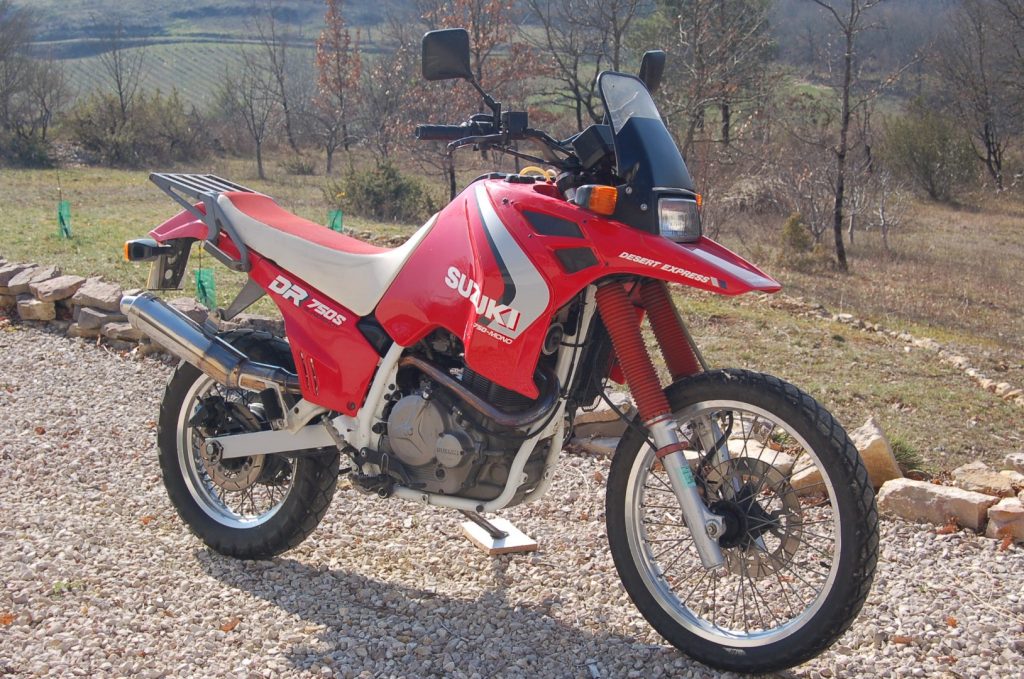
Although not a supermoto it does have the upright riding position and long travel suspension – just lacking the sticky tyres and stonking front brake. Although it has off-road pretensions this is really a road bike which could manage the odd gravel road or farm track. It has no bash plate and it way too heavy for manhandling off road. I tried it once off road but it felt much too heavy and cumbersome. On road it was pretty good and suited my purpose well, being quite happy chugging along without encouraging you to go fast. When trying to push along a bit faster on the road you soon came up against the limitations of the weak front brake (which was small and had a lot of weight to stop) and the high centre of gravity which meant swinging the bike through S bends required considerable effort. The original exhaust rusted through but I managed to find a reasonable second hand replacement.
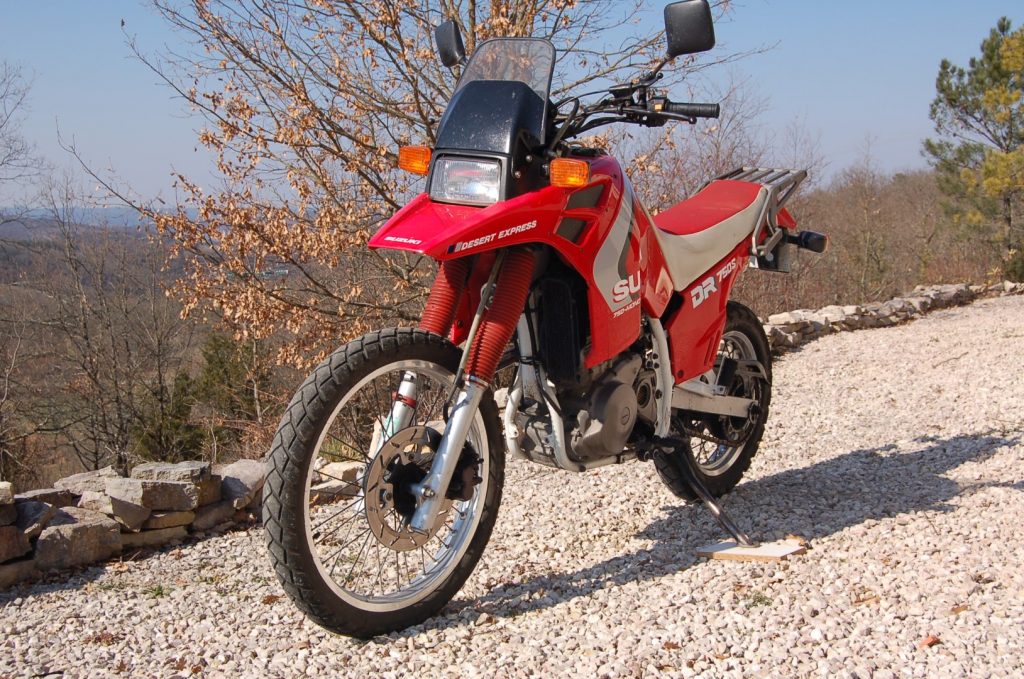
When I bought it the head bearings were extremely notchy and had to be stripped out and replaced. But other than normal servicing I didn’t have any problems with it. For a budget bike it worked very well – maybe not quite as much fun as I would have liked…
After a few more years in France c. 2010 with finances on a bit more of an even keel (i.e. we were earning more than we were spending) I started looking for an upgrade and the Supermoto itch was still there…
KTM Duke 2 640
Following the success of the KTM Supermoto (which I owned briefly) KTM developed a more road orientated version called the Duke. This was very similar to the LC4 model but with road suspension and no pretensions of going off road.
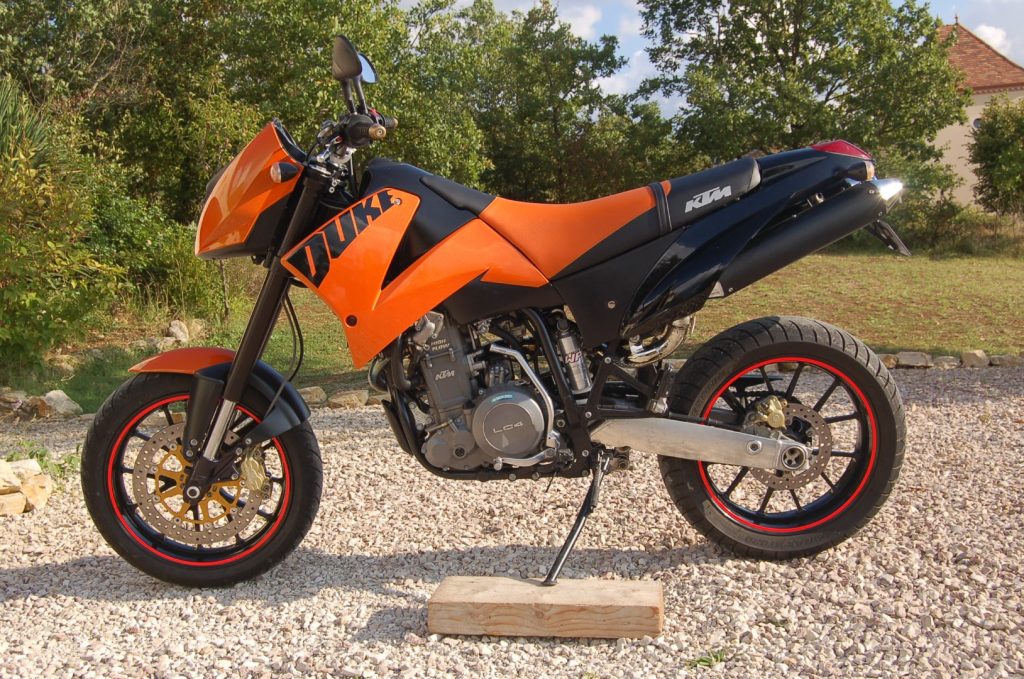
I had this bike for 7 years and spent more time polishing it than riding it – you can read my fond farewell to the bike here :
https://v2xs.com/ktm-duke-farewell/
Modifications – these involved derestricting the bike by removing emission controls, opening up the airbox, changing the jetting and de-baffling the exhaust. The exhaust work took the longest as it is made from stainless steel and quite tough – lots of cutting and grinding with a dremel. The end result looked exactly the same as stock, but sounded awesome!
Although this was my “dream bike” it was not without its faults.. Quite a lot of vibration from the single cylinder (no balancer) and in quite a high state of tune so it liked to be revved rather than chugging along. Interesting to compare it with the DR BIG which was slower and heavier but quite happy chugging along, it was OK going a bit faster but you quickly reached a limit where the bike would say “Well we can go faster, but do you really want to do that?”. In the same situation the KTM would be saying “Let’s see how fast we can go!”
And this became a bit of an issue… To ride the bike and have fun, you have to go fast which increases the risk and as the years tick by you realise more and more that you are not Captain Scarlet (indestructible). Another factor is that there are some nice A and B roads around here but they are also used by the French – a nation with the toughest driving test in the world that somehow manages to produce the worst drivers. And the government introduced a blanket 50 mph speed limit…
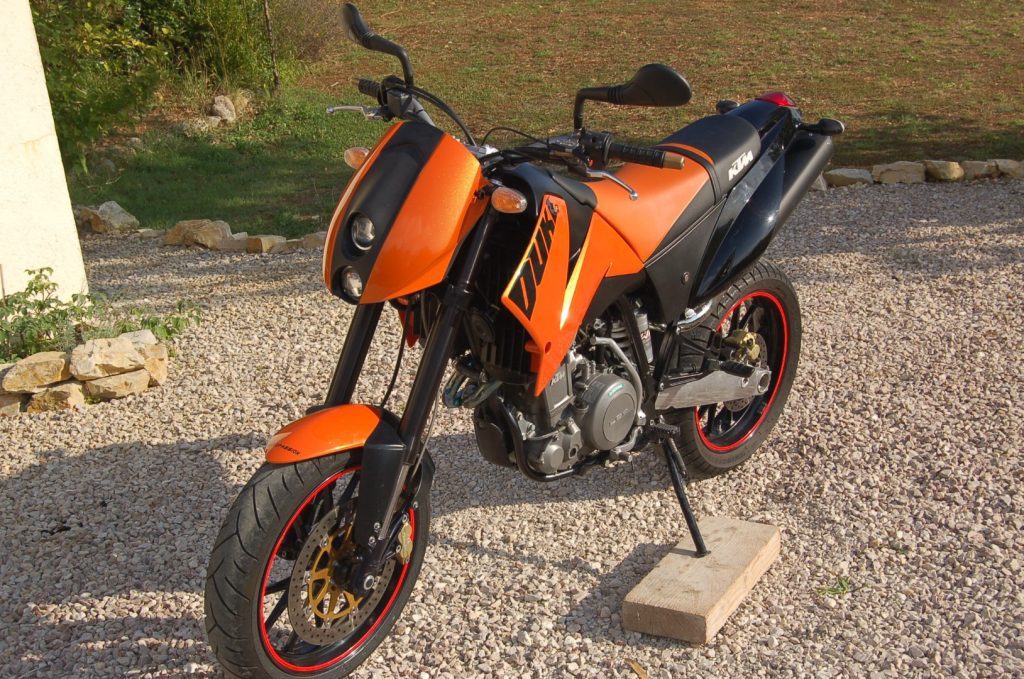
Although I no longer own any of these bikes I feel very priviledged to have been able to experience them. I am not one for accumulating stuff – preferring instead to have a few things that get used rather than a collection of museum exhibits.
You’ll have to wait until the next post to find out why I sold the KTM, or read the Farewell post above… Suffice to say that up to the present The Duke was my last road bike…
